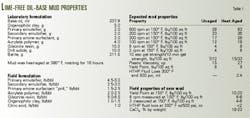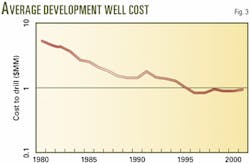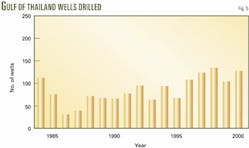Unocal Thailand Ltd. has established a lime-free, oil-based drilling fluid system as the best option for drilling wells with high bottomhole temperatures and where invasions of CO2 and other acidic gases present a host of operational and economic setbacks.
Unocal has used the uniquely engineered mud system incorporating an environmentally acceptable emulsifier package exclusively in the Gulf of Thailand, where it is primarily employed for slimhole wells (Fig. 1).
From the company's favorable experience with the lime-free drilling fluids offshore Thailand, the authors recognize the mud system to be effective for drilling any high-CO2 or high-temperature environment.
Similar examples of this environment are the Smackover Trend of Mississippi, North Louisiana and Alabama's Mobile Bay, the Matagorda area offshore Texas, some areas of the Rocky Mountains, South Texas, Tengiz, and Kazakhstan, among others.
The newly engineered drilling fluid system represents the latest development in a long-running Gulf of Thailand campaign that today is home to some of the fastest drilled wells in the world.
Prior to introducing oil-based drilling fluids, a switch to slimhole wells, enhanced bit designs, and steady improvements in drilling practices combined to record an impressive 65-day reduction in the average drilling days per well.
Owing to Unocal's emphasis on continuous improvements in drilling efficiencies, the initiative to develop a lime-free, oil-based mud system dramatically increased logging success in the theater's more difficult wells where the need for tough and ultra-thin filter cakes and very tight emulsions had posed severe restrictions.
Further, the newly engineered oil-based mud has neutralized the adverse effects of CO2 incursion while also significantly raising the temperature limitations of the preceding lime-base system to make possible the successful completion of the very hot Pailin field wells (Fig. 1).
With its inherently lower viscosity profile, which in turn reduces equivalent circulating densities (ECD) to within acceptable limits, the lime-free fluid system provides optimum rheological properties, thereby enabling the operator to also drill ultra-slimhole 43/4-in. wells.
The new system complements the continuous efficiency improvements by reducing considerably the incidents of stuck pipe and logging tools across depleted sand sections, while its capacity to deliver a superior filter cake has significantly minimized the frequency of loss circulation.
Gulf of Thailand experience
In 1962, Unocal became the first operator to be awarded exploration rights in the Gulf of Thailand and today operates 13 producing fields and has drilled more than 1,473 wells in the theater.
In the last 4 1/2 years, Unocal has drilled 515 wells and of those, 156 were drilled with the lime-free mud system, which is now used exclusively for all wells.
Most wells produce from slimhole 6 1/8-in. wellbores and a small number from ultra-slimhole 43/4-in. wellbores. The typical well averages 12,000-13,000 ft MD with wellbore angles ranging from 35 to 69° for an average of 51°.
In a typical Gulf of Thailand well, Unocal uses weighted guar gum to drill a 121/4-in. hole section to 850 ft before running the 95/8-in. casing.
After drilling out the casing shoe, the rig drills the 8 1/2-in. interval to 4,500 ft. TVD, 7,000 ft MD with seawater, then the interval is displaced with a "slick" polymer fluid to facilitate running the 7-in. casing.
The rig crew then displaces the casing with a 9.2 ppg synthetic drilling fluid and drills ahead to total depth of 9,100 ft TVD, 12,000 ft MD (Fig. 2).
In the Pailin field where bottomhole temperatures reach 400° F., drilling engineers employ essentially the same design, however, extending the casing strings deeper (Fig. 2).
Unocal's Gulf of Thailand drilling campaign includes a number of highly deviated 3D wells with inclinations up to 69° and azimuth changes as high as of 180°.
The geological environment comprises alternating sand-shale formations with numerous thin coal seams that typically exist in a complex faulted graben system. A meandering stream environment deposited the sandstone reservoirs.
Pore pressures typically increase from normal at 6,000 ft TVD to 13 ppg equivalent-mud-weight at TD. The hot Pailin field encounters a pressure regression back to normal pore pressures above TD.
Below 6,500 ft TVD, the drilling operation frequently encounters extremely hard and abrasive formations with rock compressive strengths of 7,000 psi and some streaks as high as 20,000 psi in the Pailin field.
Unocal had used several invert emulsion fluid systems in the Gulf of Thailand with varying chemical product formulations. Despite modifications to the various systems, a number of operational problems continued to hamper the drilling program.
Frequently, service companies were unable to reach bottom with openhole wireline logging tools. On several occasions pipe became stuck and bottom-hole assemblies were left in the hole.
Owing to the problems and added expenses associated with wireline formation test sampling, the ability to mudlog the percentage of CO2 gas at surface with a conventional mud logging unit could dramatically reduce time and risk. Doing so required a fluid system that would incorporate no lime in the formulation.
Furthermore, at the time the drilling program had expanded to the hot Pailin field, it was imperative the drilling-fluid system maintain stable fluid loss under high bottomhole temperature up to 400° F.
These conditions, combined with a slimhole well design and technically demanding well paths, presented a challenge for the openhole-wireline logging program.
In the Gulf of Thailand, the desire to mudlog CO2 while employing a 100% oil-based mud system possessing high temperature stability prompted a study to develop a stable invert-emulsion drilling fluid that would be effective without the presence of lime, especially when an acidic gas such as CO2 would be encountered.1
The subsequent research program led to the development of the new drilling fluid comprising an oleaginous liquid, an amine surfactant having the structure R-NH2, wherein R represents a C12-C22 alkyl group or alkenyl group.2
Fluid development
In traditional invert emulsion fluids, the aqueous fluid emulsifies into an oil phase.
Standard nonaqueous systems comprise oil or another oleaginous liquid that makes the continuous phase, water or another nonoleaginous liquid for the discontinuous phase, and an emulsifying agent. The emulsifier or surfactant reduces the interfacial surface tension of either the oleaginous or nonoleaginous liquid, forming the emulsion between the two.
Addition of the emulsifier or surfactant enables the affected liquid to form a stable dispersion of fine droplets in the other liquid, thereby lowering the interfacial tension. The smaller the droplets of dispersed liquid, the more stable the emulsion. Essential in maintaining emulsion stability and providing a source of free calcium for the formation of calcium soaps, these drilling fluid systems require lime or similar alkaline materials to maintain reserve alkalinity.
However, the presence of CO2 and other acidic gases weaken invert emulsion fluids, often to the point of failure. Additions of lime are effective in combating the effects of these acidic gases. Unfortunately, because of the acid gas reaction with lime, mud loggers cannot determine the percentage of CO2 in the mud returns, which is important for drilling operational reasons.
Oil-based drilling fluids containing lime also propagate gelation problems and display extremely high rheological properties when high levels of CO2 are encountered. The quality of the filter cake deteriorates severely and swab and surge pressures increase when pulling out of the hole for logging.
Early in the development of the new lime-free drilling fluid system, researchers investigated statistical data from the Gulf of Thailand campaign and discovered successful open-hole logging programs correlated with low drilling-mud-to-formation fluid loss at high bottom-hole temperature.
The researchers observed that hole size influenced by fluid loss and filter cake build-up played an important role in logging program success. Logging success rate dropped to less than 80% when the wellbore, indicating filter cake build-up, was smaller than 6.15 in. ID.
Furthermore, logging problems increased threefold and job success rate dropped to 70% when the wellbore size was more than 6.42 in. ID. This hole enlargement suggested that washouts, as large as 10% by volume, and ledging were associated with high fluid loss.
When the borehole diameter was considered normal between 6.15 and 6.42 in. ID, 90% of all logging jobs were successful.
The researchers uncovered that bottomhole temperature and exposure time affected borehole quality. Bottomhole temperature depends on depth, and exposure time depends on the degree of directional difficulty.
The researchers discovered that higher downhole temperatures and longer drilling times resulted in larger boreholes. From this, engineers determined that both heat and exposure time affect high-temperature, high-pressure (HTHP) fluid loss, which subsequently affects the wall cake quality.
Along with the high-temperature environment found in the Pailin field, drilling operations encounter a pressure regression prior to drilling into the main reservoir. Accordingly, the fluid becomes 3 ppg overbalanced across the reservoir.
This mud weight overbalance in combination with high bottomhole temperature generates ideal conditions for thick wall mud cake to develop, which in turn elevates the risk of stuck pipe and logging tools.
Engineers also found that in order to improve the filter cake, low-gravity solids in the mud must be maintained at an absolute minimum.
After an extensive study, Unocal increased the number of centrifuges and upgraded the shale shakers, keeping typical low-gravity solids content of the mud below 60 lb/bbl, while simultaneously drilling at penetration rates averaging 250 fph.
These correlations prompted Unocal Thailand to initiate an offshore mud heat-aging program, with extensive field-testing conducted on the rig and performed on the fluid from every well.
Results indicated that fluid loss capabilities of the mud systems were deteriorating severely with elevated temperature and exposure time. In fact, a typical HTHP fluid loss value of 3 cc was often near 40 cc when statically aged for only 24 hr at 400° F.
System formulation
Initial formulation of the lime-free, oil-base mud system required an oleaginous liquid amine surfactant as the primary emulsifier.
Later, an HSE-driven project, initiated to replace the liquid amine with a neutralized precipitate of the liquid's active ingredient, resulted in a product with dramatically reduced toxicity and irritation characteristics.
The new product received a slight hazard rating as opposed to the liquid amine, which was corrosive and classified with a severe hazard rating. The new dustless "prill" product now carries a Category 1 status, attesting to its exceptional HSE profile and user-friendly properties.
Like its predecessor, the solid prill acetic acid and amine surfactant forms a rheologically stable oil-base fluid, specifically at high temperature, and contamination with acidic gases like CO2 and H2S has been shown to pose no adverse effect on rheologies and HTHP fluid losses.
Along with the lower toxicity base emulsifier package Unocal is using Saraline 200 synthetic oil refined from natural gas with an aromatic content approaching zero. The amount of oleaginous fluid, which preferably is a mineral or synthetic oil, varies depending on the application.
In the ideal Gulf of Thailand formulation, Unocal uses a 90:10 oil-water ratio fluid. Unlike conventional systems, the new mud systems use no fatty acids. Hence, lime is not required to improve the emulsion.
In the conventional mud systems used offshore Thailand, acidic gases reacted with lime weakening the invert emulsion and caused adverse effects on filtration and rheological properties.
Eliminating the need for lime by using new organic surfactants and emulsifiers and adding an acrylate polymer-thermoplastic resin to maintain rheology and control HTHP fluid loss, were the keys to the success of the new system (Table 1).
Operational guidelines
As long as the individual components are mixed properly and well-dispersed in the fluid, the method of preparing the drilling fluid is not particularly critical. Generally, rig crews can mix the components together in any order under agitation.
The rig can mix the appropriate amounts of oleaginous fluid and amine surfactant together with continuous mild agitation, adding the other surfactants and components later, according to one recommended method of preparing the system.
Once all other components are mixed properly, the crew adds any required weighting material.
Depending on the application, engineers can optionally specify viscosifying agents such as organophilic clays, oil-soluble polymers such as modified vinyl acrylate polymers and derivatives, polyamide resins, and polycarboxylic acids.
Usually, mud engineers incorporate such viscosifying agents in amounts that are at least 0.01% to 5% by weight of the total fluid.
Once prepared, the rig maintains the fluid system like a conventional invert emulsion system with only minor modifications. While conventional invert systems require lime to function effectively, mud engineers sometimes add citric acid to the new system, and additionally after drilling cement, to ensure it remains a nonalkaline fluid.
The mud system incorporates CO2 gas in the form of carbonic acid while drilling, enabling it to remain nonalkaline.
The addition of primary and secondary emulsifiers and the primary amine surfactant maintain the emulsion stability of the system at more than 600 volts, even though the emulsion stability measurement is slightly lower than that of conventional systems.
Researchers allowed the emulsion stability to decrease to 300 volts with no signs of deterioration in the form of free water in the filtrate.
The lime-free oil base mud system has maintained an HTHP fluid loss of below 2 ml and, more recently, less than 1.0 ml with additions of gilsonite resin and modified acrylate polymer.
Based on static heat aging tests performed on fluid samples from all wells at 400° F., after 24 and 72 hr, researchers determined that fluid loss remained lower and much more stable when the acrylate polymer concentration was maintained above 1.5 ppg.
Further fluid testing also revealed that fluid loss could be reduced by 40% with the addition of 1 ppg of citric acid, and remained stable at oil:water ratios from 90:10 to 95:5.
The lime-free mud system maintains its fluid rheology with premium organophillic clay and the HTHP fluid loss-reducing polymer. The polymer increases the low-end rheology of the system once it has been adequately sheared and exposed to higher bottomhole temperatures.
Performance
Throughout the Gulf of Thailand, Unocal has proven the lime-free, oil-base mud system extremely effective in drilling wells where acidic gases adversely affect the rheologies and fluid loss properties of systems without having to incorporate lime to maintain reserve alkalinity.
Unocal Thailand has drilled more than 156 wells with the lime-free invert emulsion system, dramatically increasing logging success, minimizing mud-related nonproductive time, and contributing greatly to continued reductions in costs and days on location (Figs. 3 and 4).
These are some of the fastest-drilled wells in the world (Fig. 4). For example, Unocal drilled the Funan J-13 well to a 9,882 ft TD in 46 hr, which included running and cementing two casing strings. The engineers believe this to be a world record.
Unocal drilled and completed 14 wells on the Funan J platform in 62 days, for an average of 4.4 days/well, which included running and cementing two casing strings plus the monobore production tubing. The Funan J wells averaged 10,379 ft MD with average wellbore deviation angles of 46°.
Fig. 5 shows a steady increase in the number of wells drilled every year. The discovery of oil in addition to plentiful gas reserves, a rebound of Thailand's gas demand, and the improved efficiencies that have reduced well cost all combine to allow this aggressive drilling program. The number of wells drilled is expected to continue the upward trend over the next 3 years.
Since 1998, Unocal Thailand has achieved a 94.5% success rate in wireline-conveyed logs, to within 100 ft of TD, with significantly improved log quality. Unocal drilled many of those wells in the Pailin field with an average borehole deviation angle of 43° and average bottom-hole temperature of 374° F. and, in the case of the new ultra-slimhole wells, a production zone diameter of 43/4-in.
Engineers are developing new equipment and procedures to take advantage of the drilling fluid system's unique ability to facilitate CO2 surface mud logging. Drilling operations personnel have observed reductions in torque for 3D wells, from the high oil content of the lime-free mud system.
Furthermore, engineers performing statistical analysis of the field data reveal the lime-free, oil-base mud system has yielded optimal fluid parameters, correlating with higher percentages of successful logging runs and in-gauge hole.
Acknowledgments
The authors thank Unocal Thailand Ltd. and M-I Llc. for permission to publish this article. We would also like to acknowledge the Unocal Thailand drilling department, the M-I R&D group, and the men who drilled the wells.
References
- Harrison, J.R., Stansbury, M., Patel, J., Cross, A.T., and Kilburn, M., "Novel Lime-Free Drilling Fluid System Applied Successfully in Gulf of Thailand," SPE paper 52817, presented at 1999 SPE/IADC Drilling Conference, Mar. 9-11, 1999, Amsterdam.
- Patel, A.D., Patel, J., and Oehler, H., "Oil-Based Drilling Fluids Suitable for Drilling in the Presence of Acidic Gases," US Patent Office, No. 09/108,025 (patent pending), June 30, 1998.
The authors
James Harrison is the district drilling engineer for Unocal Thailand, based in Bangkok. In his 20 years of experience, he has held various engineering and management positions in Louisiana and Thailand. He holds a BS in petroleum engineering from Louisiana State University.
Assanee Meepornsom is a senior drilling engineer for Unocal Thailand. He has 2 years of experience in drilling and 7 years in petroleum and well services engineering. Meepornsom holds a BS in petroleum engineering from Chulalongkorn University in Bangkok.
Mark Stansbury is the country manager for M-I Thailand, based in Bangkok. During his 29 year career, he has held a number of engineering positions in both the US and some 29 other countries. He holds a BS in general business from Louisiana State University.
Gordon Petrie is manager of sales and engineering for M-I Thailand, based in Bangkok. He has 29 years of experience working primarily in the North Sea, the Far East, and Thailand. He holds an HN degree in chemistry from Aberdeen's Robert Gordon's Institute of Technology.












